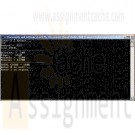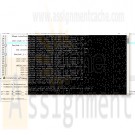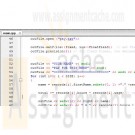Search results for 'DBM 502 LEARNING TEAM WEEK 1-6 Kelsey Elementary School project'
-

INF 231 Week 5 Assignment Final Project Dollars to Coins CPP
$12.00INF 231 Week 5 Assignment Final Project Dollars to Coins CPP
The Final Project consists of building an executable monetary conversion program to be submitted by the final day of the course.
Focus of the Project For the program, you will write a utility that converts dollars to coins.
It is a simple program that must have the following:
• Multiple outputs to the screen
• At least one input
• The use of integers and strings
• Looking or repetition with Do..While, If..Else
• Must have some output text to show correct value of coins that would be converted from the dollars.
• Code must include comments explaining your reason for the code section or what the code is doing
• Code must compile
• Whole dollars only. If value is less than 1 or 0, the program should break or exit.Turn in your source code (.cpp file) to your instructor with your filename including your first and last name and your compiled executable.
Learn More -

Lab 2 Logic Structures scoring application for an archery competition
Regular Price: $20.00
Special Price $15.00
Lab 2 Logic Structures scoring application for an archery competition
In this project you will be writing a scoring application for an archery competition. For the purpose of this assignment, assume that the competition will be divided into four ends (rounds). Three archers will compete. You will create a console C++ program that uses a nested loop to enter each archer's individual end scores and then displays the total score for each archer. Also calculate and display the overall average end score.
Note: This lab does not require the use of arrays. Do not use them. We will write a similar program with arrays later in the course.Input/Output Sequence
The program should prompt for each of the end scores for the first archer, then display the first archer's total score before moving on to the next archer. The overall average end score is the last output displayed.
Input Validation Include domain (range) validation in your solution. The lowest score an archer can have for one end is zero. The highest is 60 (based on six arrows). If the user enters a value outside of that range, the program should display an error message and re-prompt. Validation for non-numeric input is also required.Processing and Output
Target archery scores are always whole numbers. Display the average scores to one decimal place.General Requirements
Learn More
• Include an opening comment with your name, the name of the program, the date, and a short description.
• Follow the style guide! Use descriptive names and sensible data-types for variables, constants, arrays, functions, etc. that follow our naming conventions. Use good spacing and make sure braces ({}) are located where they are supposed to be.
• Attach one unzipped source code file (.cpp) to the assignment. Nothing else please. -

OOP2200 Lab 8 Structs and File I/O CPP
Regular Price: $15.00
Special Price $12.00
OOP2200 Lab 8 Structs and File I/O CPP
This lab assignment will be completed by pairs of students. Submissions by individual students will not be accepted under normal circumstances. The intent is that the two students work together. In this lab you will be creating a “Plain-Old-Data” structure to store basic pay record information. You will use that structure to store raw pay record data read from a data file and produce a formatted report as a text file.Raw Data
The data file "hours.txt" (provided), stores data for a number of employees. Each employee is recorded as follows: first name, last name, number of hours worked this week, and wage-per-hour. It currently contains the following data, but please note the file your instructor uses to test your program may contain a different number of records.
John Smith 25.0 15.00
Mary Jones 33.5 17.50
Pat Brown 40.0 21.00
Jen Simpson 37.5 18.00
Gary Phillips 15.0 11.25PayRecord struct
Create a data structure called PayRecord that has data-members for each of the four fields of information we are recording: first name, last name, number of hours worked this week, and wage-per-hour. When you read a line from the input file, you will be storing it in a PayRecord struct.Reading the Input File and Writing to the Output File
Read raw data from the "hours.txt" data file (using your PayRecord struct) and produce a report in a file called "pay.txt". The report must contain the following:
• Each employee name in the format first initial only, followed by ".", followed by last name. (e.g. Thom MacDonald becomes T. MacDonald)
• The pay for each employee (hours worked * wage) formatted as currency.
• The grand total paid to all employees for the week.
Use the following may as a guide. You should try to match the format of this report as closely as possible.
YOUR NAME
PAY FOR THIS WEEK
=========================
J. Smith $ 375.00
M. Jones $ 586.25
P. Brown $ 840.00
J. Simpson $ 675.00
G. Phillips $ 168.75
=========================
Total: $ 2645.00Notes:
Learn More
1. Ensure that both the input and output files open properly. You should not process any file that is not open. Ensure to close both files when complete.
2. Each employee occurs in the data file one time only. If any of the names appear in your report more than once, you have made a logic error.
3. You are not required to output the report to the screen.
4. One viable approach is to read one line from the input file and then write one line to the report in a loop until there are not more records. Another approach is to read all the records in the input file into a vector first, then produce the report from the vector. Either approach is fine. There is no explicit requirement to read and store all of the pay records before you begin writing the report.
General Requirements
• Include an opening comment with both partner's names, the name of the program, the date, and a short description.
• Follow the course coding standards! Use descriptive names and sensible data-types for variables, constants, functions, etc. that follow our naming conventions.
• Use good spacing and make sure braces ({}) are located where they are supposed to be, and indentation follows Allman style.
• Attach your unzipped source code file(s) (.cpp, .h) to the assignment folder. Nothing else please.



